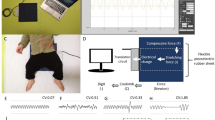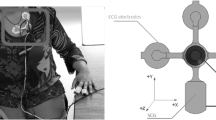Abstract
Long-term monitoring of heart rate, respiratory rate, and body movement in neonates would be useful for preventing illnesses, such as respiratory disorders. However, currently, there is no noninvasive monitoring system available for neonates. Therefore, in this study, we proposed a modified, noninvasive, piezoceramic-facilitated biometric system to allow measurements of heart rate, respiratory rate, and body movement of neonates. We designed a monitoring system for neonates based on a sensor device with four piezoceramics, which were placed beneath the four legs of a neonatal bed. The output signal from the sensor device was measured as overlaps of the heartbeat, respiration, and body movement components. To test our system, we studied a 7-week-old male preterm infant who was admitted to the neonatal intensive care unit. To determine the validity of our system, electrocardiogram and respiratory waveform output from a conventional bedside monitor were used as references. We observed that the heartbeat signal that was detected by a piezoceramic sensor and that by ECG was similar. Similar findings were also observed between the respiration signal detected by a piezoceramic sensor and the reference respiration signal. In our method, the heartbeat and respiration signals could be accurately measured in the segments in which no body movement was generated. Use of piezoceramics avoids the need for applying sensors to the neonatal body. Our proposed monitoring method would be useful for neonates who require long-term monitoring in the hospital and after discharge, as well as for research purposes.







Similar content being viewed by others
References
Barak M et al (1989) The use of a synthetic skin covering as a protective layer in the daily care of low birth weight infants. Eur J Pediatr 148(7):665–666
Brouillette, Robert T et al (1987) Comparison of respiratory inductive plethysmography and thoracic impedance for apnea monitoring. J Pediatr 111(3):377–383
DeGroff CG, Bhatikar S, Hertzberg J, Shandas R, Valdes-Cruz L, Mahajan RL (2001) Artificial neural network–based method of screening heart murmurs in children. Circulation 103(22):2711–2716
Ommen SR, Nishimura RA, Appleton CP, Miller FA, Oh JK, Redfield MM, Tajik AJ (2000) Clinical utility of Doppler echocardiography and tissue Doppler imaging in the estimation of left ventricular filling pressures a comparative simultaneous Doppler-catheterization study. Circulation 102(15):1788–1794
Bouwstra S, Chen W, Oetomo SB, Feijs LMG, Cluitmans PJM (2011) Designing for reliable textile neonatal ECG monitoring using multi-sensor recordings. In: Engineering in Medicine and Biology Society, EMBC, 2011 Annual International Conference of the IEEE, IEEE, pp 2488–2491
Ciaccio EJ, Hiatt M, Hegyi T, Drzewiecki GM (2007) Measurement and monitoring of electrocardiogram belt tension in premature infants for assessment of respiratory function. Biomed Eng Online 6(13):1–11
Sato S, Ishida-Nakajima W, Ishida A, Kawamura M, Miura S, Ono K, Takahashi T (2010) Assessment of a new piezoelectric transducer sensor for noninvasive cardiorespiratory monitoring of newborn infants in the NICU. Neonatology 98(2):179–190
Bani Amer MM, Az-Zaqah R, Aldofash AK, Mohammad AY, Dameer AM (2010) Contactless method for detection of infant sleep apnoea. J Med Eng Technol 34(5–6):324–328
Tsai SY, Thomas KA (2010) Actigraphy as a measure of activity and sleep for infants: a Methodologic study. Arch Pediatr Adolesc Med 164(11):1071–1072
Nukaya S, Shino T, Kurihara Y, Watanabe K, Tanaka H (2012) Noninvasive bed sensing of human biosignals via piezoceramic devices sandwiched between the floor and bed. Sens J IEEE 12(3):431–438
Shino T, Nukaya S, Kurihara Y, Watanabe K, Tanaka H (2011) Development of unconstrained biosignal bed sensing method using piezoceramics to detect body movement and scratching motion. In: SICE Annual Conference (SICE), 2011 Proceedings of IEEE, pp 2317–2321
Acknowledgments
This study was supported in part by a Grant from the Fukuda Foundation for Medical Technology, Tokyo, Japan.
Author information
Authors and Affiliations
Corresponding author
About this article
Cite this article
Nukaya, S., Sugie, M., Kurihara, Y. et al. A noninvasive heartbeat, respiration, and body movement monitoring system for neonates. Artif Life Robotics 19, 414–419 (2014). https://doi.org/10.1007/s10015-014-0179-4
Received:
Accepted:
Published:
Issue Date:
DOI: https://doi.org/10.1007/s10015-014-0179-4




